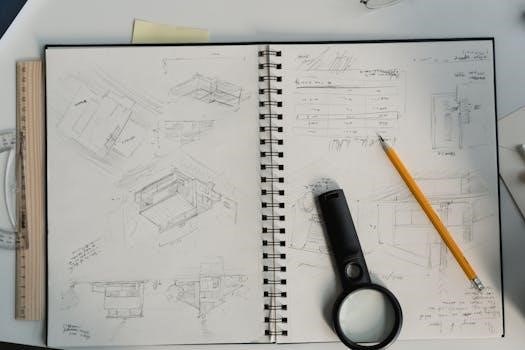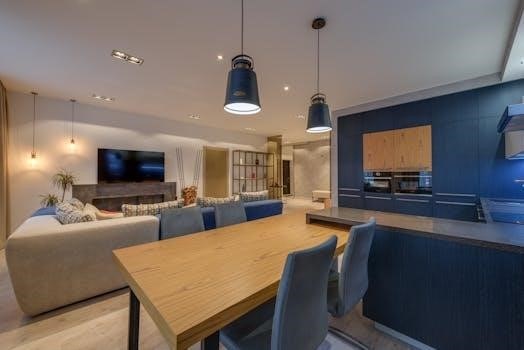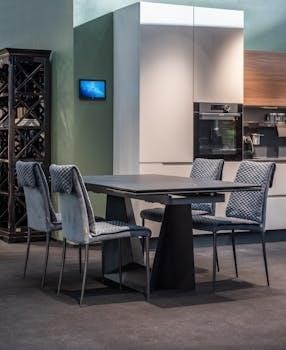Dining Room Table Plans PDF⁚ A Comprehensive Guide
Embark on crafting your dream dining space with our detailed guide to PDF table plans. Explore various designs and learn how to build a unique, custom table.
Dining room table plans in PDF format offer a fantastic resource for both novice and experienced woodworkers aiming to create their own custom furniture. These plans provide a structured approach to building, detailing every step from initial cuts to final assembly; Unlike generic guides, PDF plans often include precise measurements, material lists, and detailed diagrams, thus minimizing guesswork and potential errors. They allow for customization, giving you the freedom to adjust dimensions and materials to suit your unique space and preferences. The convenience of a downloadable PDF means that you can access your plans anytime, anywhere, and refer to them as often as necessary throughout your project. Whether you’re envisioning a rustic farmhouse table or a sleek modern design, PDF plans can be your guide to bringing your dream to life. They are a cost-effective and empowering way to furnish your home with a personal touch.
Understanding PDF Plans
PDF plans for dining room tables are essentially digital blueprints that provide a comprehensive roadmap for your woodworking project. These documents typically contain several key components, starting with an overview of the finished table, followed by detailed technical drawings. These drawings use specific symbols and notations to communicate measurements, angles, and assembly sequences. Understanding these symbols is crucial to accurately interpreting the plan. Furthermore, the PDF format allows for easy zooming and printing, making it convenient to work from a digital screen or a hard copy. PDF plans also often include exploded views which show how each part fits together and can be invaluable during the assembly process. While the complexity of a plan can vary, a well-structured PDF plan is designed to be clear and easy to follow, even for those with limited woodworking experience. The goal is to eliminate ambiguity and ensure a successful build.

Types of Dining Room Tables
When exploring dining room table plans, you’ll discover a diverse range of styles and shapes, each catering to different spatial needs and aesthetic preferences. The most common types include rectangular, round, and square tables. Rectangular tables are a popular choice for larger spaces, offering ample seating and a classic feel. Round tables, on the other hand, are ideal for promoting conversation and creating a more intimate atmosphere. They are particularly suitable for smaller spaces or where a more social setting is desired. Square tables are a versatile option, working well in compact areas and providing a sense of balance and symmetry. Within each of these basic shapes, there are countless design variations, such as pedestal bases, trestle styles, and extendable tops, allowing you to personalize your table to perfectly match your dining room decor and functional needs. Choosing the right shape is the first step in creating a beautiful and functional space.

Rectangular Table Plans
Rectangular table plans are among the most sought-after, given their versatility and capacity to accommodate larger groups. These plans typically feature detailed dimensions for various sizes, ranging from smaller tables seating four to expansive designs capable of hosting ten or more. A typical rectangular plan will include precise measurements for the tabletop, legs, and any supporting structures, ensuring a stable and well-proportioned final product. You will also find information on different leg styles, such as straight, tapered, or turned legs, and joinery techniques like mortise and tenon or pocket screws. Many plans also offer options for extending the table, allowing for flexibility in seating arrangements. These adaptable plans cater to diverse aesthetics, encompassing modern, rustic, and traditional styles, making them a great choice for many homes.
Round Table Plans
Round table plans offer a unique approach to dining spaces, fostering a more intimate and conversational atmosphere. These plans typically detail the construction of circular tabletops, often specifying the use of techniques like edge banding or segmented construction to achieve a smooth, continuous surface. The plans also cover various base designs, including pedestal bases, which are common for round tables, and four-legged configurations. The diameter of the table is a crucial element, and plans will often present options for different sizes, accommodating different numbers of diners. You will also find details about constructing the base to properly support the round top and ensure it is sturdy. Round table plans often feature details on decorative elements, like routed edges or inlay work, enhancing the table’s visual appeal. These designs are great for smaller spaces or for those who prefer a less formal and more inclusive dining setting.
Square Table Plans
Square table plans present a balanced and symmetrical design, suitable for various dining room layouts. These plans often focus on creating a stable and robust structure, detailing the construction of the tabletop and the legs or base. The plans will specify the exact measurements for each side, ensuring a perfect square shape. Typically, square table designs are simpler than round ones, often employing straight cuts and joinery techniques that are relatively straightforward to execute. They might include options for solid wood construction, or incorporate panel or veneer techniques for the tabletop. Base designs can range from four individual legs to more elaborate trestle or pedestal styles, all of which are meticulously detailed in the plans. Square tables are excellent for maximizing space in smaller areas, while providing a comfortable and functional dining area.
Essential Elements in a PDF Plan
A well-crafted PDF plan for a dining room table will include several crucial elements to guide you through the construction process. Primarily, it will feature precise measurements and dimensions for every part of the table, from the tabletop to the legs or base. The plan must also include a comprehensive material list, specifying the type and quantity of wood, fasteners, and any other necessary materials. A step-by-step instruction guide is also essential, outlining the building process in a logical and easy-to-follow manner. These instructions should include diagrams or illustrations, to clarify each stage of the assembly. Furthermore, the plans may also feature details about necessary tools, finishing techniques, and safety considerations. These elements combined create a comprehensive document that will allow you to successfully build your dining room table.
Measurements and Dimensions
Accurate measurements and dimensions are the cornerstone of any successful dining room table project. Within a PDF plan, this section provides the precise size of each component, ensuring a perfect fit and structural integrity. You’ll find details on the tabletop’s length, width, and thickness, as well as the dimensions of the legs, aprons, and any other structural elements. These measurements are typically presented in a clear and concise manner, often using both imperial and metric units to accommodate different preferences. Diagrams and illustrations are usually included, showing where each measurement applies on the table. This detailed approach minimizes errors and ensures that your final product matches the intended design, and the correct size is achieved. These details are critical for accurate material cutting;
Material Lists
A comprehensive material list is an indispensable component of any good PDF plan for a dining room table. This list provides a detailed breakdown of all the materials you will require to complete your project successfully. It typically includes the type and quantity of lumber, such as hardwood or softwood, specifying the dimensions needed for each piece. You’ll also find the necessary hardware listed, including screws, nails, bolts, and any specialized fasteners. The list extends to include any adhesives like wood glue, as well as any finishing products such as stain, varnish, or paint. This crucial section helps ensure you purchase the correct materials in the right amounts, preventing unnecessary trips to the store, and that you have everything required. Some lists may even include links to suggested suppliers, increasing the convenience.
Step-by-Step Instructions
Clear, concise, and detailed step-by-step instructions are the backbone of a usable PDF plan. These instructions should guide you through the entire construction process, from preparing the materials to the final assembly. Each step should be explained thoroughly, often accompanied by diagrams or illustrations to enhance understanding. The instructions should cover cutting the lumber to the required dimensions, assembling the frame, and attaching the tabletop. They should also provide guidance on any necessary joinery techniques like mortise and tenon or dowel joints. The steps should logically progress, ensuring that each task is completed in the correct order for a seamless build. Finishing touches, like sanding and applying protective coatings, should also be explained clearly. A well-written set of step-by-step instructions will enable even novice builders to complete the project with confidence.
Choosing the Right PDF Plan
Selecting the perfect PDF plan is crucial for a successful woodworking project. Consider your skill level carefully; some plans are designed for beginners, while others are better suited for experienced woodworkers. Assess the complexity of the design, and choose a plan that matches your current abilities. Think about the style and design preferences of your dining area. Do you prefer a modern, rustic, or traditional aesthetic? Ensure that the table’s dimensions will fit comfortably in your space. It is also essential to factor in the tools and equipment you have available. Some plans may require specialized tools you do not have, so it’s best to choose a plan that uses tools you own or can easily access. Taking time to evaluate these aspects ensures a smoother, more enjoyable building experience.
Skill Level Assessment

Before diving into a project, accurately assessing your woodworking skill level is essential. Beginner plans often feature simpler joinery and fewer steps, focusing on basic techniques like cutting and assembling. Intermediate plans may introduce more complex joinery methods and require a higher level of precision. Advanced plans often involve intricate designs, custom features, and require a complete understanding of advanced woodworking skills and techniques. Examine the plan carefully, noting the types of joints, tools, and techniques it requires. If you are new to woodworking, choose a beginner-friendly plan with clear instructions and minimal complex steps. Starting with a plan that aligns with your current skills will result in a more successful and less frustrating project. Don’t hesitate to start with simpler projects to build your confidence.

Style and Design Preferences
Your personal style and the overall design of your dining space should significantly influence your choice of table plan. Consider whether your home has a modern, rustic, traditional, or contemporary aesthetic. For a modern space, minimalist designs with clean lines and simple forms might be suitable. Rustic designs, on the other hand, often incorporate natural materials and a more organic look. Traditional styles usually feature more ornate details and classic silhouettes. Think about the existing decor, colors, and materials in your dining area. Also, consider your seating needs⁚ a small, round table might work best for smaller spaces or intimate gatherings, while a large rectangular table is more suitable for bigger groups. Choose a plan that not only matches your taste but also enhances the functionality of your space.
Finding and Accessing PDF Plans
Locating the perfect PDF plan for your dining table project is now easier than ever, thanks to a plethora of online resources. Numerous websites specialize in offering woodworking plans, often categorized by style, complexity, and table type. Many reputable sites offer both free and premium plans, with premium options usually providing greater detail and support. Online marketplaces dedicated to crafts and DIY projects are also excellent places to find diverse and unique plans. Don’t forget to explore forums and communities of woodworkers, where members frequently share their own plans or recommend good sources. Before downloading, check customer reviews or comments about the plan’s clarity, accuracy, and the overall user experience. Carefully consider the file format and ensure that you have the necessary software to open and view the PDF plans without any issues.
Conclusion⁚ Getting Started with Your Project
With your chosen PDF plan in hand, you’re now poised to embark on the exciting journey of building your custom dining room table. Remember, thorough preparation is key to a successful project. Carefully review all the plan’s instructions, measurements, and material lists before you begin. Gather all necessary tools and materials, ensuring they are of good quality to achieve the best results. If you are a beginner, consider starting with a simpler plan to gain experience and confidence. Don’t hesitate to seek advice from experienced woodworkers if you encounter difficulties. Building a table is a rewarding experience. Take your time, be patient, and enjoy the process of creating a functional and beautiful piece of furniture for your home. With careful planning and execution, your new dining table will be a source of pride and joy for years to come.
